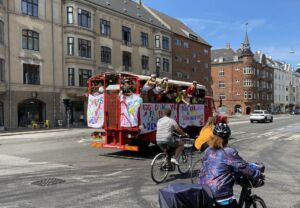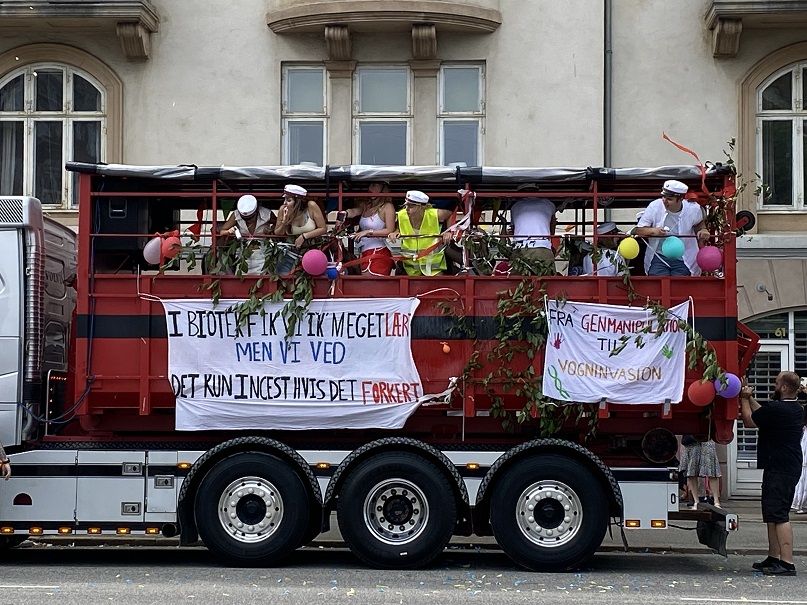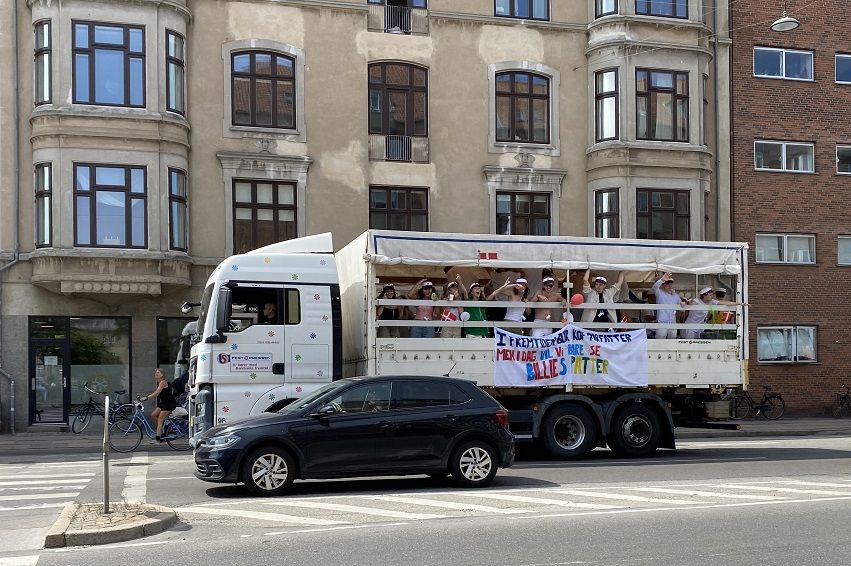Opinion
Partying hard – and celebrating the nation
This article is more than 2 years old.
On this, the final weekend of June, young people are again be driving around town shouting and dancing. It may look like Danish youngsters drinking their brains out once again. But there’s a deeper sense to the madness, a professor explains

Friday lunchtime … it’s going to be a long day (all photos: Uffe Jørgensen Odde)
They sing, they dance, they shout, they drink.
They celebrate that they finally, after three years in upper-secondary school, can put on the special white cap they call ‘studenterhuen’.
As internationals have most likely experienced around Midsummer’s Day, youngsters drive around town in open trucks while people in the streets wave back at them.
On the day of ‘Studenterkørsel’ – the day when a class drives around town – they visit their classmates’ homes where parents, other family members and sometimes friends congratulate them on finishing their exams.

A rite of passage
According to Professor Emerita Dr Phil Margit Warburg, from the Department of Cross-Cultural and Regional Studies at the University of Copenhagen, there’s a sense to the madness – much more than just Danish youngsters partying hard and drinking their brains out while being feted by their loved ones.
“The graduation is a rite of passage that youngsters go through in three phases: the isolation phase, the transition phase and the final phase, where they reintegrate into society,” Warburg said.
She has researched the traditions of all Danish high schools and, according to Warburg, the students began driving around towns in the 1930s. Back then horse carriages were used. But the purpose hasn’t changed.
“On the day of driving around they in fact behave really crazily, but as society we think they are incredibly sweet despite their madness. In fact, when we wave or honk our horn, we are thanking them for their future work for Denmark,” she said.

A tribute to Denmark
So when the young graduates sing, dance and drink their way along streets across the country, they aren’t just celebrating themselves.
In fact, all the traditions are part of a ritual that pay tribute to the nation of Denmark, Warburg explains.
“Today the young women are typically dressed in white or red – the national colours. The truck is often adorned with beech branches, which is no coincidence, as the beech is the Danish national tree. The Danish flag, Dannebrog, is usually also present,” she said.
The symbol that caps it all
Finally there’s the student cap, which is a central object and symbol in the ritual.
“You cannot wear the cap before graduation. That will lead to misfortune and you’ll, according to the myth, never graduate,” Warburg said.
The cap, first introduced by traditional upper-secondary school graduates in the 1850s, is also red and white and equipped with the Dannebrog cross. This cross is connected to the nation – not Christianity in itself, Warburg explains.
If you look closely you’ll see there is a small mark on the front of the cap’s desk. It’s the cockade.
In the centre of it sits a small metal cross, which is the national bow-armed cross that you see in the Dannebrog order founded by Christian V in 1671.
This is, according to Warburg, to remind the Danes that God helped the nation to victory when the Dannebrog fell from the sky during a battle near Tallinn in Estonia in 1219. The myth says the flag gave the fighting troops more courage, which led to a Danish victory.
“So it’s not just some random cross,” Warburg said.

Sex is in the air
In recent years, even though the cross is not only a Christian symbol, young people who believe in other religions can have other symbols on the cap.
“And if you’re an atheist, you can have a maple leaf. I think that’s very inclusive,” Warburg said.
There’s also sex in the air. In Copenhagen many students drive to Kongens Nytorv, where they dance around the equestrian statue.
“A horse is a large virile animal. As a society we embrace that because we need future generations. These traditions and celebrations are all about creating a better future society – and sex is a key to that. And the graduation also symbolises the transition from being a child to a grown-up,” Warburg concludes.
The original cap
1856: Studenterhuen, the cap, arrives in Denmark after originating at Nordic student meetings. At this time the brim is black.
1880s: The brim of the cap becomes white, and it is decorated with red ribbon. The cap is called the ‘summer cap’ and back then the cap was only worn by men.
1930s: Women adopt the white student cap. The tradition of driving around towns in horse carriages begins.
1970s: Graduates taking the higher preparatory exam (HF), higher trade exam (HHX) and higher technical exam (HTX) get their own student caps. Later on graduates from various other schools get a cap. Today a lot of them also drive around towns celebrating.
Source: Videnskab.dk and Margit Warburg.
Todays different caps
When the cap was introduced it was for students graduating from the traditional upper-secondary school exclusively. Today many other students, graduating from other types of secondary schools, wear a white cap – but with different colors on the ribbon. Not all of them have the Dannebrog cross on them.
The red – the original
Worn by students who graduate from the traditional upper-secondary school (STX).
Light blue
Worn by students who graduate after taking the higher preparatory exam (HF).
Royal blue
Worn by students who graduate after taking the higher trade exam (HHX).
Marine blue
Worn by students who graduated after taking the higher technical exam (HTX).
Flags
Worn by students who graduate from an IB school.

About










































